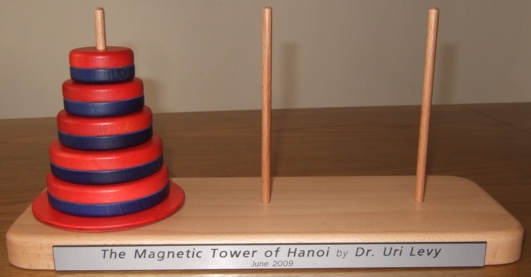Invented and analyzed by
Dr. Uri Levy
June 2009
The classical Tower of Hanoi (ToH) "puzzle" or "mathematical game", invented by the French mathematician Edouard Lucas in 1883, spans "base 2". The number of moves of each disk is given as a power of 2 and the total number of moves required to solve the puzzle with N disks is 2N - 1.
But what about "base 3"? Can we modify the Tower's rules to span base 3?
Yes we can. By modifying the rule of a disk move and by adding a "magnetic" constraint, the now highly challenging Magnetic Tower of Hanoi puzzle (MToH) spans base 3 with a breath-taking elegance.
Not only number 3 stars in the analysis, but the game is intricate. The puzzle solution may progress in more than one path. The puzzle presents more than one option to the player. The Tower therefore calls for thinking and hesitation. It is Freedom that makes the MToH so colorful.
If you want to test your skills with this puzzle you can go to:
Magnetic Towers of Hanoi (Young @ Science).
Or:
Magnetic Towers of Hanoi (Seth Weiss).
For a more detailed description of the new puzzle and the theory behind it open the following -
Wikipedia:
Magnetic Tower of Hanoi
Documents:
The Magnetic Tower of Hanoi.pdf (Abstract)
Magnetic Towers of Hanoi and their Optimal Solutions.pdf (Abstract)
Presentation:
The Magnetic Tower of Hanoi.ppt (might take a few minutes to load)

The movie below shows a solution of the 5-disk MToH puzzle by (only) 83 moves. Each disk has a north-pole side (blue) and a south-pole side (red). The color of a disk in the movie represents its current top color. According to the rules of this game when a disk is lifted off a post it is first turned upside down and then can land only on a larger disk of the same orientation.